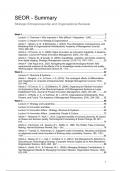Resume
SEOR - Detailed Summary of ALL Lectures and Articles! 2025
- Cours
- Établissement
I scored an 7.8 on the exam by only studying this summary! Detailed Summary for master course Strategic Entrepreneurship and Organizational Renewal of the master Business Administration Strategy and Organization.
[Montrer plus]



